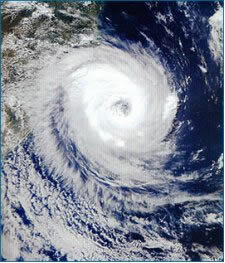Hurricane or typhoon are nomenclatures used to designate a type of cyclone, that is, atmospheric eddies that rotate around a center of low atmospheric pressure. Depending on the geographic location and its intensity, this phenomenon can be called several others names such as hurricane, typhoon, tropical storm, cyclonic storm, tropical depression or simply Hurricane.
Typhoon – is the nomenclature used for the highest intensity tropical cyclones occurring in the Northwest Pacific Ocean, west of the international date line. It occurs mainly in South Asia and the western part of the Indian Ocean, having the same characteristics of a hurricane.
Hurricane - is a tropical cyclone formed in the North Atlantic Ocean, Northeast Pacific Ocean, east of the international date line, and in the South Pacific Ocean, east of longitude 160°E.
Do not stop now... There's more after the advertising ;)

Satellite image of a hurricane
A hurricane is the most violent of all storms, and its life cycle can be a few days. It is an atmospheric phenomenon that begins in warm seas (above 24°C) and is normally 1,500 kilometers long. It is formed by immense circular bands of clouds that rotate around the eye, ie, the center of this storm, which is usually 35 kilometers wide. In the eye of the hurricane (center) the winds are milder, different from the rest of the storm, where they can reach a speed of 360 km/h.
By Wagner de Cerqueira and Francisco
Graduated in Geography
Would you like to reference this text in a school or academic work? Look:
FRANCISCO, Wagner de Cerqueira e. "Typhoon and Hurricane"; Brazil School. Available in: https://brasilescola.uol.com.br/geografia/tufao-furacao.htm. Accessed on June 27, 2021.


